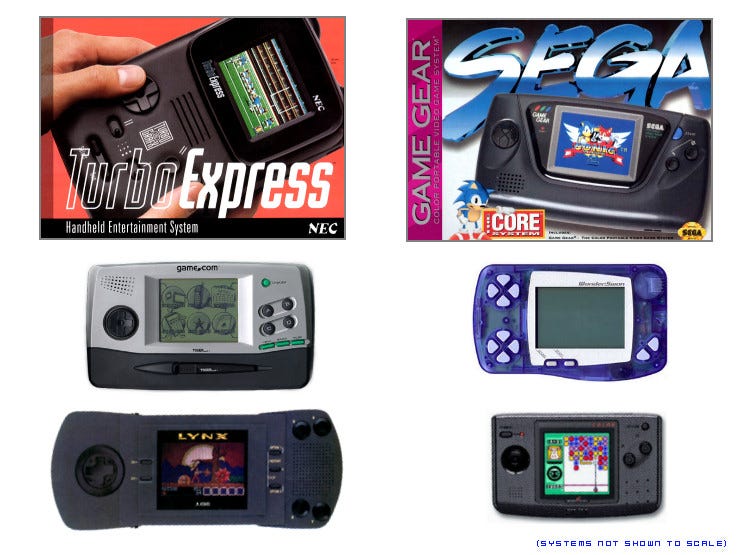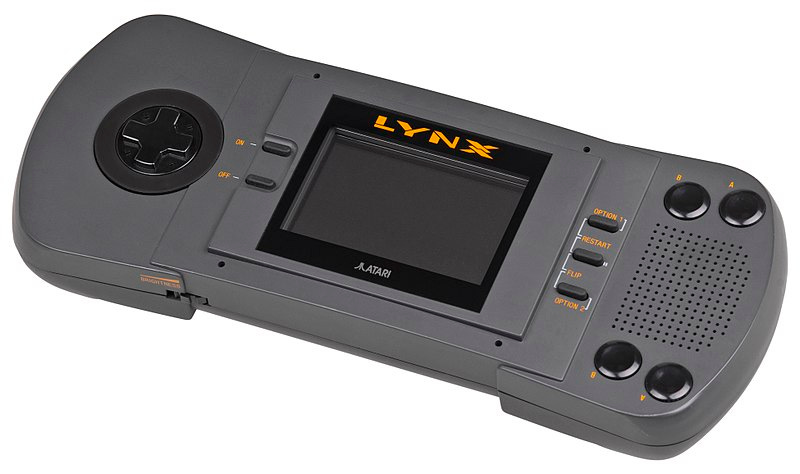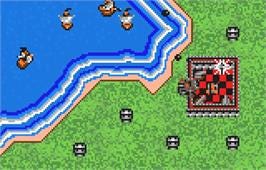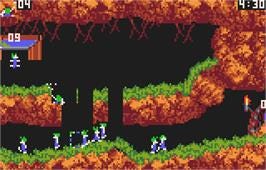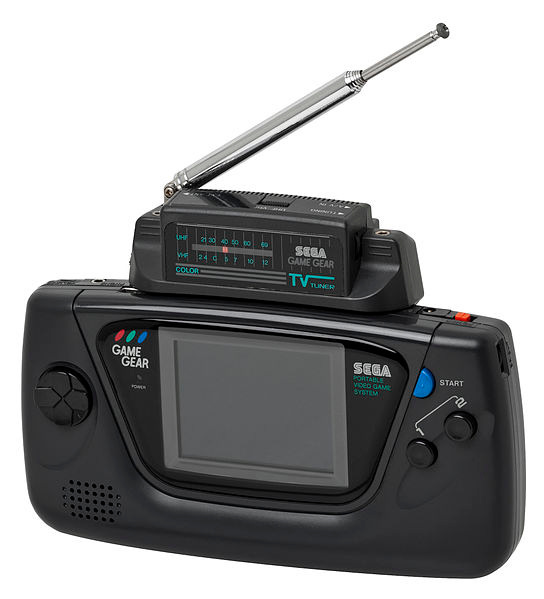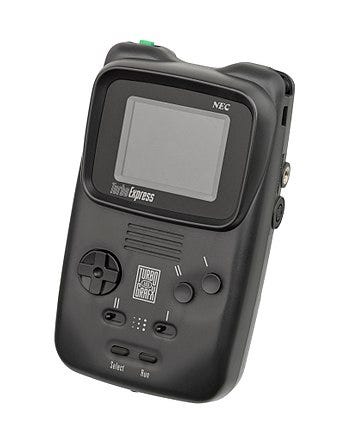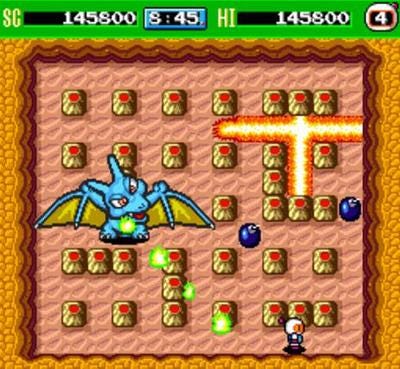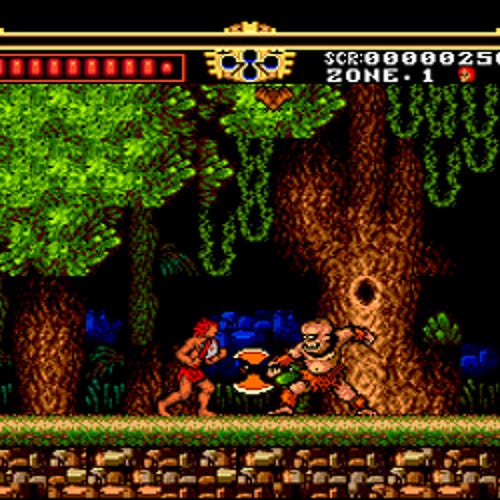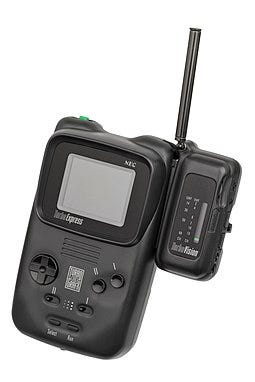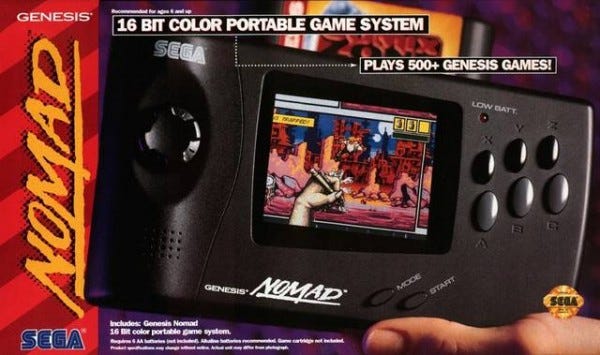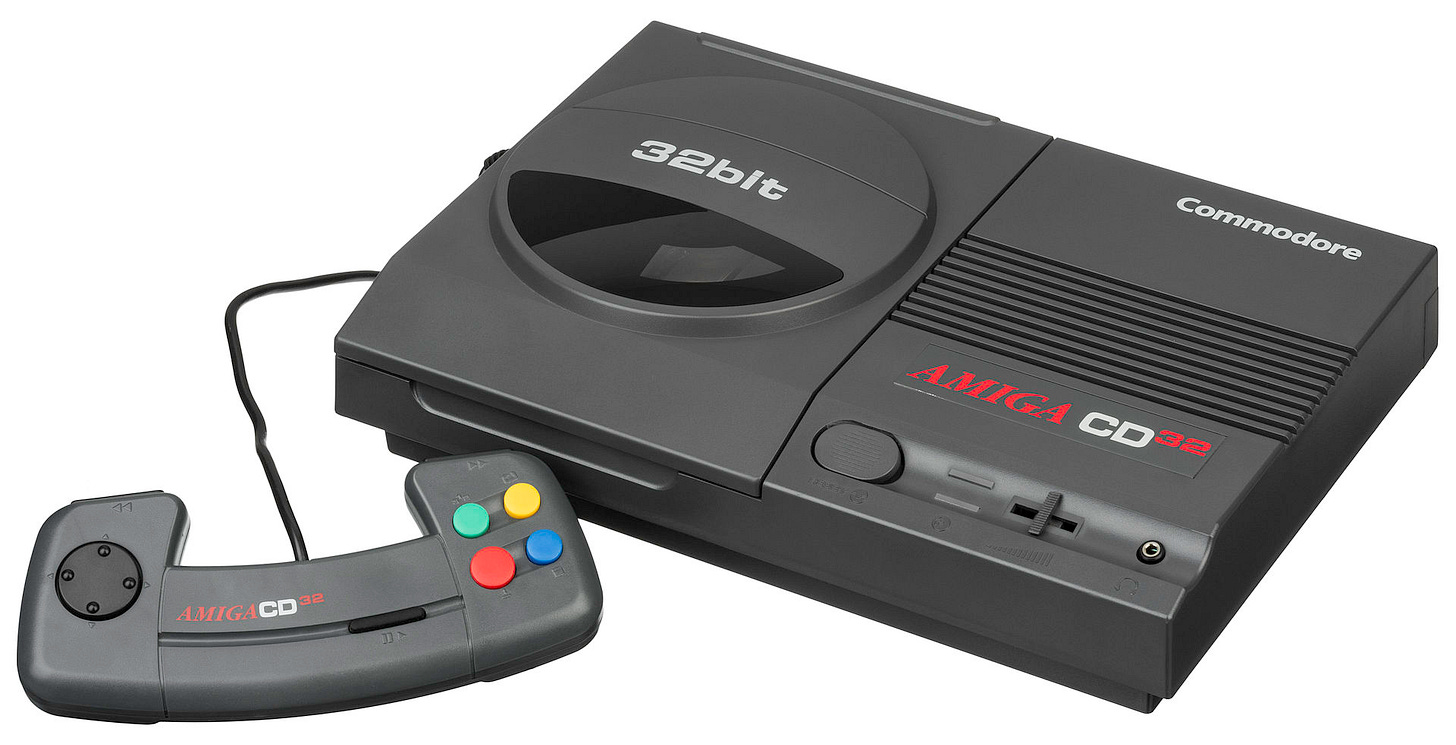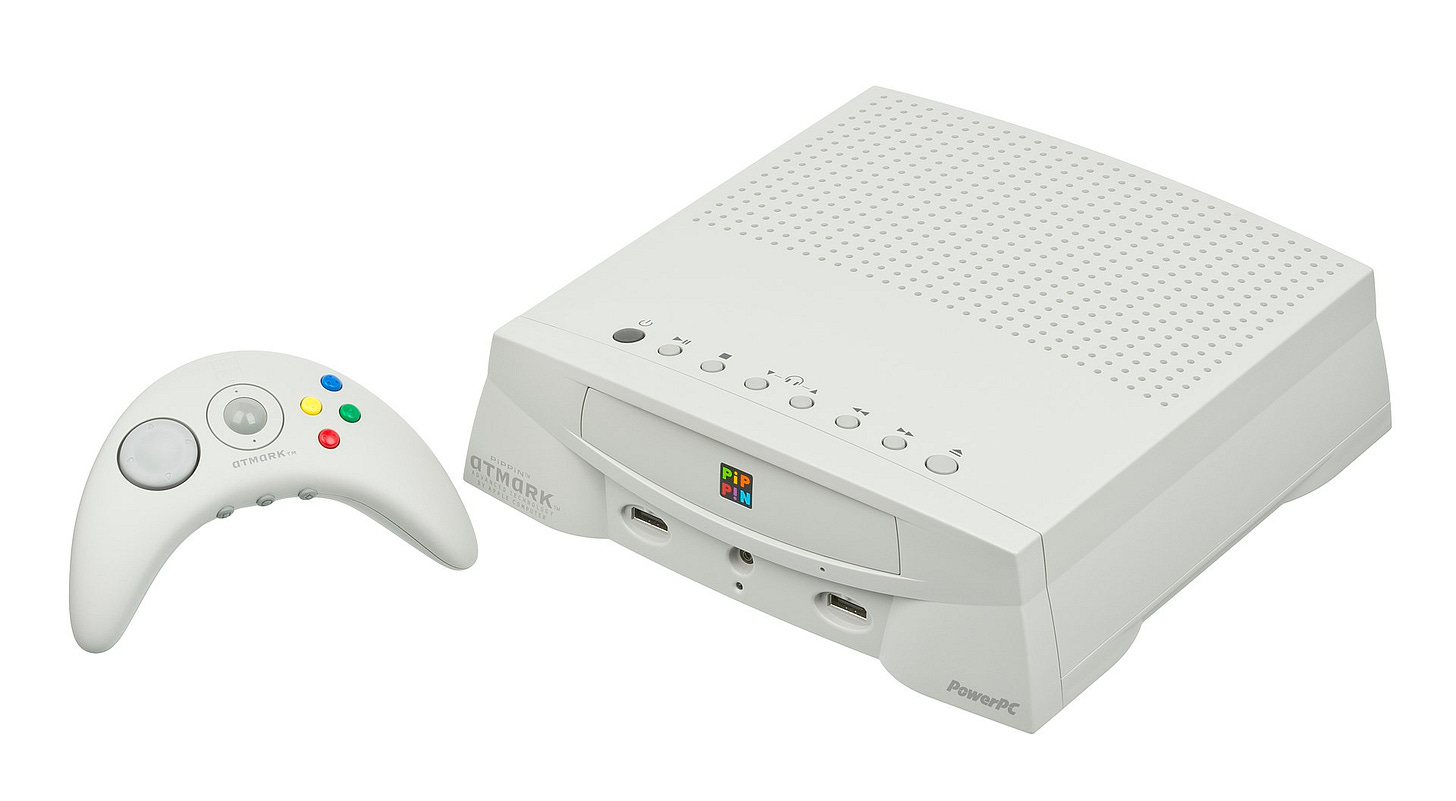What If: Nintendo never released the Game Boy?
What company would have won the hand-held war? SEGA? NEC? Atari? Someone else?
I love a good, nerdy hypothetical.
Earlier today Benj Edwards (Associate Editor for How-To Geek), posed the following hypothetical that I find absolutely irresistible:
What if Nintendo never released a general purpose, multi-game hand-held console? Read: What if they never made the Game Boy?
Oh, boy. What a fascinating thought experiment!
Before I dive to deep here: I highly recommend the writing of Benj Edwards. He’s one of the few Tech Journalists, working today, that seems to have a good understanding of Computing History… and he clearly loves it.
So. 1989 comes and goes. No Game Boy. Never happened.
Who wins the hand-held console war?
Well. There was another hand-held game console released in 1989:
The Atari Lynx
This was a pretty gosh-darned impressive machine.
Color, back-lit screen with 4,096 colors
Multiplayer gaming (able to network up to 8 Lynx’s… in theory 16… but it only really worked for 8)
The CPU was a variant on the 6502, with 64k of RAM (though ROM had to be loaded into RAM at launch, which resulted in less usable RAM than the 64k)
A custom 16-bit co-processor (named “Suzy”) that handled math, sprite scaling, and all sorts of fun sprite effects
4 Channel sound with 8 Bit DAC
Fun Tivia: The Atari Lynx was the brainchild of two men… Robert J. Mical, who created the graphical user interface for the original Amiga (among other components). And Dave Needle who created much of the custom chip work in the original Amiga. These men are absolute legends in the computer and gaming world.
They joined a company called Epyx, specifically to create the Lynx, at the request of a man named David Morse. Who is David Morse? Well, he’s another legend. Co-founder, and original CEO, of Amiga during the original creation of the Amiga 1000.
Epyx went out of business not long after partnering with Atari on Lynx production. Thus Atari took total control of the Lynx platform going forward.
The Lynx had some pretty remarkable games, some of which really showcased the hardware. A few of my favorites:
What could have happened had the Lynx not needed to compete with the Nintendo Game Boy juggernaut? Already having an impressive set of games, would more third party developers have jumped on board?
I think that seems pretty darn likely.
Then, roughly one year later (at the end of 1990), two other portable consoles entered the fray (within roughly two months of each other)… the NEC Turbo Express and the SEGA Game Gear.
The SEGA Game Gear
Beating the Turbo Express to market by less than two months, the SEGA Game Gear was, in essence, a portable version of the SEGA Master System home console.
Like the Atari Lynx, the Game Gear had a backlit, color screen capable of 4k total colors.
Z80 CPU
Slightly higher resolution than the Lynx (160 × 144 vs Lynx’s 160×102)
Only 8KB of main RAM (and another 16KB of video RAM)
In some ways the Game Gear was superior to the Lynx. In other ways inferior. It was, realistically a fairly mixed bag in that regard.
Where the Game Gear really shined — though many reviewers at the time disagreed with my views on this — was in the fact that the hardware was, for the most part, compatible with the long established SEGA Master System. Which, while not having the sales numbers of the Nintendo Entertainment System in the 1980s, still had an impressive library of classic games.
This allowed many games to be quickly ported — and new games to be made by teams that already understood how to squeeze the most out of the hardware.
Some great examples of Master System Games:
So many more. Truly the Game Gear had a huge number of titles. Some of which were absolutely spectacular.
You’ll note that the Game Gear had a far more “square” screen than the Lynx… which was a bit “widescreen”.
The Game Gear also had an optional TV Tuner, which let you watch Over-the-Air standard UHF and VHF television right on your hand-held. Which, let’s be honest, is just plain cool.
NEC Turbo Express
Then, just two months later, the Turbo Express hits. Which was, essentially, a portable TurboGrafx-16 home console.
CPU was a HuC6280, up to 7.16 MHz — an 8bit CPU with two 16bit GPUs
400 x 270 display (512 total colors available, 481 on screen at a time, 64 sprites)
Used thin “HuCards” instead of cartridges
Turbo switches for the two action buttons
Because the Turbo Express was essentially a portable version of the TurboGrafx-16, all existing games for that system were instantly compatible using the exact same “HuCards” that the home console uses.
You’ll note that resolution — and simultaneously on-screen colors — is a massive leap over both the Atari Lynx and the Game Gear. The TurboGrafx-16, while in many ways still an 8-bit home console (like the NES or Master System), really benefited from those 16bit GPU’s. And the many of the games took glorious advantage of that power.
Truly beautiful.
Like the Game Gear, the Turbo Express had an accessory that let you watch TV: The Turbo Vision. Which also had an RCA input, which meant you could use the Turbo Express as a portable TV which you could hook up a VCR or other home console into. Which is pretty freaking nifty.
Thus ends 1990
Ok. Here we are, at the end of 1990, with three powerful, full-color, hand-held game consoles.
The Lynx, the Game Gear, and the Turbo Express.
In later years, more home consoles would appear. Including the Game.com (1997) , The Neo Geo Pocket (1998), and the Bandai Wonderswan (1999). But, since the three hand-helds we’ve covered so far would have been competing on the market for over half a decade — without any Nintendo interference — I think it’s safe to assume that this crop of late 1990s hand-helds might not have even happened.
Fun side note: The Bandai Wonderswan was created by Gunpei Yokoi… who also created the Nintendo Game Boy (in addition to the Nintendo Game & Watch systems). Legen-wait-for-it-dary. But, if Yokoi never created the Game Boy… would he have gone on to create the Wonderswan at all? Who knows. Maybe that’s the key change in this hypothetical, Game-Boy-free reality. Perhaps Yokoi, instead of creating the Game Boy, decides to retire from video games and opens a Bed and Breakfast.
So. Who won the war? Which company — NEC, SEGA, or Atari — would dominate hand-held gaming?
I think there are two answers here. What console I would have liked to have won… and what console I believe actually would have.
Who I would root for
I would have loved to see the NEC Turbo Express dominate the market (or at least tie with the market leader).
I love the feel of the hardware. And the “16 bit quality” of the graphics really gave the system staying power. If it had sold better than it did in real life, we could have seen several years of strong third party support.
Imagine this: What if Rare, Apogee, Bethesda, Capcom, Konami, and others had good reason to invest in the TurboGrafx-16 / Express as a primary platform?
The Turbo Express could have been the must-have handheld console. Oh, it would have been glorious.
Who I think would have won
SEGA.
Without question SEGA would have won the handheld battle… had the Game Boy not existed.
Did the Game Gear have the most powerful hardware? No. No, it did not.
But it had Sonic. Plus a hefty collection of Master System ports. And, just as the Game Boy had Tetris… the Game Gear had Columns.
It also had the SEGA magic behind it. Without Nintendo sucking up all the oxygen in the room, realistically, many third party developers would have turn their attention to the Game Gear.
Why not the Atari Lynx? Too big. Way, way too big. And Atari, by 1990, just couldn’t manage things. Their computers, their consoles, and their games… they just didn’t seem to know how to seize on their best assets anymore.
Why not the NEC Turbo Express? Their hardware was spectacular. And they truly did have some great games. But the HuCards couldn’t save games… they relied on memory on the system for saves… which the Turbo Express did not have. Portable gamers were not going to love “Password Saves” while on the go. This could have been fixed with an update to the Turbo Express… but they still would lack… Sonic. Bonk just didn’t grab the public in the same way.
What I think is really interesting… is what might have happened after the Game Gear achieved market dominance. What would SEGA have done next?
In the real world, in 1995, SEGA released another hand-held: The SEGA Genesis Nomad.
As the Game Gear was, essentially, a portable Master System (with smaller cartridges)… the Nomad took the whole idea a step further: It accepted actual SEGA Genesis cartridges. And had a TV-output. Plus a port for a second controller.
Would SEGA have continued down that path and released the Nomad? Or would it have changed course and created a new, portable-first system?
It’s fun to ponder on.
I suppose, in the end, I would have loved to see the SEGA Game Gear and NEC Turbo Express duke it out in the hand-held market through the early to mid-1990s.
Then… by the late 1990s… NEC and SEGA release “Next Generation” handhelds to compete with each other.
Gosh, that would have been a fun ride.
One other crazy thought
With no Nintendo Game Boy — and a market possibly split between NEC and SEGA — that opens things up for another company to get involved in the mobile space during the early to mid 1990s.
What company? Well. How about… Commodore?
In 1993, they rolled out their Amiga-based console, the CD-32.
What if — what if — Commodore had seized on that opening in the hand-held market to create a hand-held console based either on early Amiga hardware or, dare I say, C64/C128 hardware?
It may seem silly, but the graphical capabilities of a C64 is actually pretty in line with the hand-helds we talked about above. And being able to quickly port over the massive library of C64 games would give the handheld a big boost right from the start.
Or — hold my drink — what about Apple?
They released the Newton hand-held PDA in 1992… so they were already moving down the hand-held road. And we know Apple had eyes on the gaming market. Just look at the ill-fated Pippin home console from 1996.
Now, imagine this:
By 1993, the hand-held market is dominated by the SEGA Game Gear and the NEC Turbo Express.
Success in the portable space, boosts third party support and retail sales of NEC and SEGA’s home consoles significantly.
Then, in 1994, both Commodore and Apple enter the market with hand-held game consoles of their own.
What happens then?
Atari goes out of business (because that’s what Atari does). Nintendo releases their Super Nintendo / Super Famicom… but only sees significant sales in Japan… and is a minor player in North America / EU.
In response, many of the third party developers that (back in our Universe) focused on the SNES and Game Boy are now looking to SEGA, NEC, Commodore, and Apple to develop both exclusives and ports.
Likewise… Nintendo, facing declining hardware sales, begins porting to other consoles… and even developing exclusives for some of them. Mario on NEC. Zelda on SEGA.
“But… but… Lunduke! What about SNK and the Neo Geo line?!”
I believe that, in this Game Boy free Universe… SNK would do almost exactly what they did in the real world. Release the Neo Geo MVS… then the home consol. Then the CD version of the Neo Geo. Then, at the end of the 1990s, the Neo Geo Pocket. All of which would be respected machines, with some fun first-party fighting games. But none of the consoles would dominate the market.
As a wise man once said, “SNK gonna SNK”.
“Who said that, Lunduke?”
I did. Just now.
Lunduke.Substack.com — Lunduke.Locals.com — Reddit — Twitter
Current subscriber exclusives for The Lunduke Journal:
eBooks: Lunduke's Dad Jokes About Computers, vol. 1, Linux for Hank (kids book), Half a Decade of Linux-y Shenanigans, Lunduke Journal Quarterly - Volume 1, Paper Doll Tux, Road-Sign Hank & the Aliens (comic book), Operating System Not Found (choose your own adventure)
Games: Linux Tycoon (Linux, Windows, DOS), 2299 (Linux, Windows)
+ Exclusive Podcasts, Articles, & 24x7 Telnet BBS Access



